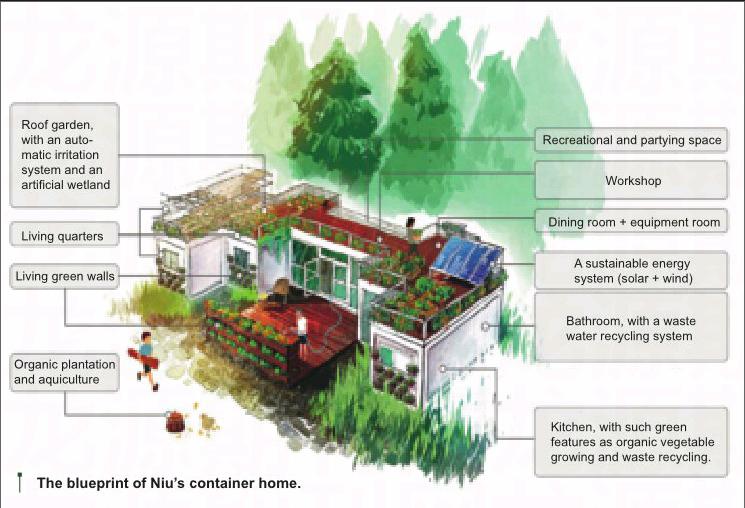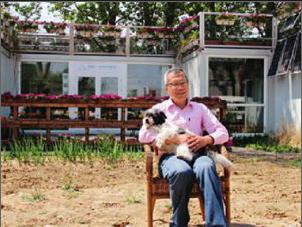Niu Jian,Urban Eden Dweller
By+staff+reporter+LU+RUCAI


AT the end of May the second phase of Niu Jians sustainable living lab project was completed at Beijings International Camping Park. It is designed as a training camp that helps citizens make the transition to a more sustainable, freer lifestyle.
Niu, 53, is an active advocate and innovative doer of green living. Last summer, he and his family built a shipping container modular home in Beijings suburbs that features several environment-friendly concepts and practices, such as a roof garden, living green walls, and a waste recycling system. The building has lured many admirers who hanker after a green lifestyle in the big city. “Everyone can make it as long as they have the will,” Niu said.
A Family Project
Niu now lives in the container home he personally designed and built in an abandoned factory in Shunyi District, 40 km from downtown Beijing. The building consists of six iron-sheet, 20-foot-long containers, and is divided into sections that serve as living quarters, an office, a kitchen, a bathroom, and a maker space. The roof is installed with solar and wind power facilities, and the walls are kitted out for vertical plantation, which means that both outer and inner walls and the ceiling are densely covered in vegetables and flowers.
Visitors flock to the green living lab on an almost daily basis, and all are welcomed. “I never ask about their occupations. I talk to them freely as long as they will listen, and I say the same to everyone,” Niu said. He has good reasons to do so, as these visitors come with the same question in mind: Whats it like to live in an urban Eden?
The living quarters of Nius container home includes two bedrooms, one of which is for the Niu couple and also serves as Nius study, and the other one is for their son, who is studying at college and only occasionally pays a short visit. There are another two smaller rooms, one for Mrs. Niu, a Buddhist, used as a prayer room and study, and one to accommodate visiting volunteers. The corridors between these rooms and the dining room and kitchen double up as the volunteers workshop.
The most prominent green features of the construction are in the kitchen and bathroom. The commode is flanked by four buckets. One is for greywater, wastewater generated from kitchen sinks, washbasins, showers, and laundry. Treated greywater and rainwater is channeled into a bucket for reclaimed water to flush the toilet and water plants. The other two barrels are for the fermentation of feces and kitchen waste, which produces biogas or manure for the plants. The roof is lined with a rain collection system, along with solar panels that generate electricity for the LED lighting for vegetation growing on the walls.endprint
According to Niu, the house, merely a prototype, is not yet energy self-sufficient. The solar power it generates is for plant cultivation only. This is primarily decided by its low cost of RMB 300,000. The figure would double if solar energy were to be used for all the electricity needs of day-to-day living. “It is nothing but a technical issue. If we were to ignore costs, complete self-sufficiency would be no problem,” Niu said. What he has been doing is to explore the possibilities of a new lifestyle that fully integrates humankind into the natural surroundings.
Building Eden
Niu is from the coastal city of Qingdao in Shandong Province. As a boy he would dig up wild flowers and re-pot them at home. In 1979, when China had just kick-started its reform and openingup, Niu, then a worker at a local textile factory, for the first time saw pictures of foreign homes in a magazine and was immediately enchanted by the horticultural displays on balconies. He was inspired to build similar mini-gardens in urban homes in China, a dream that lives on to this day.
In his spare time, Niu cultivated potted plants at home, grown from seeds purchased from the south. He would then take them to the weekend wet market to sell. Business was brisk, and the revenues soon overtook his salary from the factory. At 37, he quit his full-time job, and started a horticultural business. Before long he realized his undertaking was ahead of the consumption habits and level of Qingdao, a modest-sized city, so in 2001, he moved to Beijing.
Niu found huge potential in the capital. “I took the number 300 bus for a full-circle tour of the Third Ring Road and spotted a greenery-festooned balcony only every 10 km or so,” he said. This discovery convinced him that what he was doing could make a meaningful difference to this city.
In 2005, Niu rented a space at the Institute of Vegetables and Flowers, Chinese Academy of Agricultural Sciences, to develop rooftop and balcony gardening technologies, which he later put into practice through partnership with schools, government departments, and NGOs. As the environment issue attracts more attention nationally and globally, Nius project is increasingly welcomed. “In the past, the green initia- tives using my technologies were bankrolled by NGOs who drew from public welfare funds; now, they are government purchased,” Niu said. Rooftop and balcony gardening is favored and promoted among the old neighborhoods in Beijing where open ground is scant.endprint
In 2009, Niu founded the Community Bio-tech Research Center, with the goal of changing the lifestyles of multiple households instead of modifying just one building or home. His container house in Shunyi is the centers office and an open innovation platform as well. It is open to all who have bright ideas about green communities and would like to compare notes with like-minded people.
Nineteen-year-old Duan Zhilong,formerly a cycling athlete, is a volunteer at the container house who was “reeled in by Mr. Nius Peach Blossom Land life and sustainable lifestyle.” The young man called himself a “dreamer,” and yearned to be an “active contributor to the transition to a new living pattern.”“You could say that we are both the guinea pigs and the scientists,” Niu said in reference to his experiment for a sustainable lifestyle that he believes can be replicated and applied widely.
Sharing Communities
A line on Nius business card reads: A robust association, a farming ecoenvironment, a space for sociality, a shared life, and a social enterprise – the five dimensions of a sharing community.
From rooftop and balcony gardening to a sharing community is a big leap. But Niu considers them to be the same in essence. “In the East or West, people have the same expectations of life – to be closer to nature and seek harmony between mankind and nature,” Niu said. But the industrial revolution reshaped human settlements. The leading factor influencing peoples choices on where to live is no long neighbors, but money, as Niu sees it. The seismic changes in our lives incurred by the industrial revolution have had a detrimental impact on interpersonal relations and the environment. The super concentration of the population in urban areas has interrupted the natural life cycle of the ecosystem, and ruptured interpersonal contacts, causing environmental and social problems.
Niu, therefore, conceived the idea of sharing communities where urban households can dispose of their waste at low costs, and where micro-farming not only provides safe foods but also brings together local residents. By sharing, these communities support low-carbon and sustainable living.
In the second stage of his lab, Niu and his partners established a mini sharing community that consists of three households. “It is only a training ground with the space and functions of a community,” Niu explained. “The households are taught a new lifestyle that centers on sharing and collaboration, and maintains harmonious relations among resi- dents, between mankind and the cosmos and all its life forms, and between people and nature.”endprint

In his vision, a mature sharing community evolves in three phases. In the first stage, members learn to collaborate on such issues as food supply, waste disposal, growing vegetables and flowers, handicrafts, swapping objects, transport, and group purchasing. In the second stage, they administer self-governance under laws and a community charter. The idea for the final stage is for people to design and mold their communities together with their neighbors.
“Since the industrial revolution, humankind has been attempting to lessen its negative impacts on the community, the environment, and the economy. Over the past 60 years in particular, we have been seeking a lifestyle that achieves harmony between man and man, and man and nature. Such efforts have succeeded in changing a group of people, but not the entire planet,” Niu Jian said. The goal of his lab is, therefore, to influence as many people as possible.
But is the sharing community a blow to the real estate market? Nius answer is no. “People who receive training on sustainable living will not live in containers, but residential blocks. How life goes on in such spaces is of course diverse. You could say that we are buttressing the economy and consumption. Housing designs in the past only took accommodation needs into account, but future homes factor in social, environmental, and new economic elements, boosting the economy while meeting peoples demand for an ideal life.”
Niu hopes his project will influence at least 100 million people in the coming 30 years, and will enter other countries around the world. He prides himself on the fact that the model fits developed Western countries, medium-level developing countries like China, and nonindustrialized countries alike.
Nius visitors are from all walks of life, including scholars of environmental science, NGO workers, government officials, and real estate businesspeople. He hopes that after leaving his lab, they will spread the message and make concerted efforts to build the type of community to which he aspires.endprint

